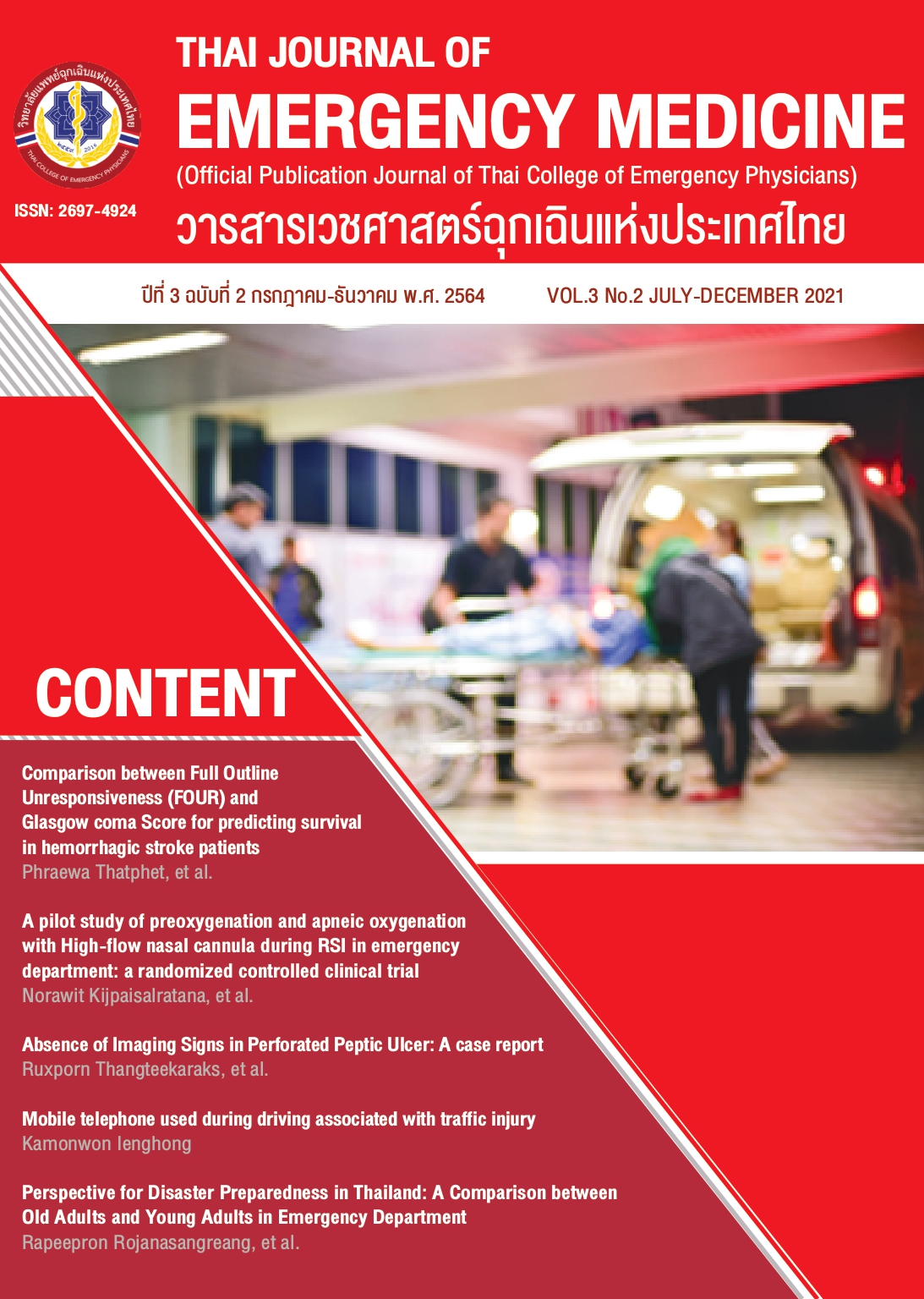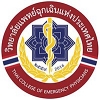การใช้ FOUR Score เปรียบเทียบกับ Glasgow coma Score ในการทำนายการรอดชีวิตของผู้ป่วยโรคหลอดเลือดสมองแตก
คำสำคัญ:
FOUR score, Glasgow coma score, โรคหลอดเลือดสมองแตกบทคัดย่อ
บทนำ: โรคหลอดเลือดสมองแตกเป็นโรคที่พบได้บ่อยในแผนกฉุกเฉิน และมีการพยากรณ์โรคที่ไม่ดี และพบว่า Glasgow coma score (GCS) มีความแม่นยำในการทำนายพยากรณ์โรคไม่ดีพอ มีงานวิจัยว่า Full Outline of UnResponsiveness (FOUR) score มีความแม่นยำมากกว่า GCSสำหรับการทำนายการพยากรณ์โรค และการตอบสนองการรับรู้ทางระบบประสาทในผู้ป่วยโรคหลอดเลือดสมองและผู้ป่วยที่ฟื้นคืนชีพจากภาวะหัวใจหยุดเต้น ดังนั้นจึงมีแนวคิดที่จะใช้ FOUR score เพื่อใช้ทำนายการรอดชีวิตในผู้ป่วยกลุ่มนี้
วัตถุประสงค์: ศึกษาความแม่นยำในการทำนายการรอดชีวิตที่ 28 วันของผู้ป่วยโรคหลอดเลือดสมองแตก โดยการเปรียบเทียบระหว่าง FOUR และ GCS
วิธีการศึกษา: การวิจัยเชิงวิเคราะห์แบบไปข้างหน้า วิเคราะห์ข้อมูลโดยใช้ STATA version 15 จากผู้ป่วยโรคหลอดเลือดสมองแตก และมาตรวจที่แผนกฉุกเฉินโรงพยาบาลชลบุรี ตั้งแต่วันที่ 1 ตุลาคม ถึงวันที่ 31 ธันวาคม 2563 จำนวน 145 คน เปรียบเทียบความแม่นยำระหว่าง FOUR และ GCS โดยใช้ความไว ความจำเพาะ ค่าพยากรณ์ผลบวก ค่าพยากรณ์ผลลบ และพื้นที่ใต้กราฟ วิเคราะห์เปรียบเทียบการเสียชีวิตที่จุดตัดด้วย Cox’s regression
ผลการศึกษา: ผู้เข้าร่วมงานวิจัยนี้ทั้งหมด 145 คน ค่าเฉลี่ยของ FOUR และ GCS เท่ากับ 8.6 + 5.9 และ 8.6+ 4.4 ตามลำดับ อัตราการรอดชีวิตของผู้ป่วยคือร้อยละ 46.9 ค่เฉลี่ยพื้นที่ใต้กราฟของ FOUR score เท่ากับ 0.934 และ GCS เท่ากับ 0.885 ตามลำดับ ในผู้ป่วยที่ค่า FOUR score มากกว่าหรือเท่ากับ 13 คะแนน มีแนวโน้มที่จะมีการรอดชีวิตที่ 28 วันมากกว่า กลุ่มที่มีคะแนนน้อยกว่า (Hazard ratio 39.21)
References
Teasdale G, Jennett B. Assessment of coma and impaired consciousness. A practical scale. Lancet Lond Engl. 1974;2(7872):81–4.
Sandroni C, Barelli A, Piazza O, Proietti R, Mastira D, Boninsegna R. What is the best test to predict outcome after cardiac arrest?. Eur J Emerg Med.1995;2(1):33-37
Udekwu P, Kromhout-Schiro S, Vaslef S, Baker C, Oller D. Glasgow Coma Scale score, mortality, and functional outcome in head-injured patients. J Trauma.2004;56(5):1084-9
Matis GK, Birbilis TA. Poor relation between Glasgow coma scale and survival after head injury. Med Sci Monit.2009;15(2):CR62-65
Fugate JE, Rabinstein AA, Claassen DO, White RD, Wijdicks EFM. The FOUR score predicts outcome in patients after cardiac arrest. Neurocrit Care. 2010 ;13(2):205–10.
Almojuela A, Hasen M, Zeiler FA. The Full Outline of UnResponsiveness (FOUR) Score and Its Use in Outcome Prediction: A Scoping Systematic Review of the Adult Literature. Neurocrit Care. 2019;31(1):162–75.
Foo CC, Loan JJM, Brennan PM. The Relationship of the FOUR Score to Patient Outcome: A Systematic Review. J Neurotrauma. 2019. 01;36(17):2469–83.
Bayraktar YS, Sahinoglu M, Cicekci F, Kara I, Karabagli H, Duman A, et al. Comparison of Glasgow Coma Scale and Full Outline of Unresponsiveness (Four) Score: A Prospective Study. Turk Neurosurg. 2019;29(2):285–8.
Temiz NC, Kose G, Tehli O, Acikel C, Hatipoglu S. A Comparison Between the Effectiveness of Full Outline of Unresponsiveness and Glasgow Coma Score at Neurosurgical Intensive Care Unit Patients. Turk Neurosurg. 2018;28(2):248–50.
Sepahvand E, Jalali R, Mirzaei M, Ebrahimzadeh F, Ahmadi M, Amraii E. Glasgow Coma Scale Versus Full Outline of UnResponsiveness Scale for Prediction of Outcomes in Patients with Traumatic Brain Injury in the Intensive Care Unit. Turk Neurosurg. 2016;26(5):720–4.
Zeiler FA, Lo BWY, Akoth E, Silvaggio J, Kaufmann AM, Teitelbaum J, et al. Predicting Outcome in Subarachnoid Hemorrhage (SAH) Utilizing the Full Outline of UnResponsiveness (FOUR) Score. Neurocrit Care. 2017;27(3):381–91.
Ramazani J, Hosseini M. Comparison of full outline of unresponsiveness score and Glasgow Coma Scale in Medical Intensive Care Unit. Ann Card Anaesth. 2019;22(2):143–8.
Iyer VN, Mandrekar JN, Danielson RD, Zubkov AY, Elmer JL, Wijdicks EFM. Validity of the FOUR score coma scale in the medical intensive care unit. Mayo Clin Proc. 2009;84(8):694–701.
Wijdicks EFM, Bamlet WR, Maramattom BV, Manno EM, McClelland RL. Validation of a newcoma scale: The FOUR score. Ann Neurol. 2005;58(4):585–93.
Buderer NMF. Statistical methodology: I. Incorporating the prevalence of disease into the sample size calculation for sensitivity and specificity. Acadademic Emergency Medicine.1996; 3(9):895-900.
Surabenjawong U, Sonmeethong W, Nakornchai T. Accuracy of Glasgow Coma Score and FOUR Score: A Prospective Study in Stroke Patients at Siriraj Hospital.J Med Thai 2017;100(9):960-6
Mansour OY. Megahed MM. Elghany EHSA. Acute ischemic stroke prognostication, comparison between Glasgow Coma Score, NIHS Scale and Full Outline of UnResponsiveness Score in intensive care unit, Alex J Med.2014;51(3):247-53
Kocak Y, Ozturk S, EGE F, EKMEKCI AH. A useful new coma scale in acute stroke patients: FOUR score. Anaesth Intensive Care.2012;40:131-6
Braksick SA, Hemphill III JC, Mandrekar J, Wijdicks EFM, Fugate JE. Application of FOUR score in intracerebral hemorrhage risk analysis.J Stroke Cerebrovasc Dis. 2018;27(6):1565-9

Downloads
เผยแพร่แล้ว
How to Cite
License
Copyright (c) 2022 วิทยาลัยแพทย์เวชศาสตร์ฉุกเฉินแห่งประเทศไทย

This work is licensed under a Creative Commons Attribution-NonCommercial-NoDerivatives 4.0 International License.
บทความที่ได้รับตีพิมพ์ในวารสารเวชศาสตร์ฉุกเฉินแห่งประเทศไทย ถือเป็นเป็นลิขสิทธิ์ของ วิทยาลัยแพทย์เวชศาสตร์ฉุกเฉินแห่งประเทศไทย
กรณีที่บทความได้รับการตีพิมพ์ในวารสารเวชศาสตร์ฉุกเฉินแห่งประเทศไทยแล้ว จะตีพิมพ์ในรูปแบบอิเล็กทรอนิกส์ ไม่มีสำเนาการพิมพ์ภายหลังหนังสือเผยแพร่เรียบร้อยแล้ว ผู้นิพนธ์ไม่สามารถนำบทความดังกล่าวไปนำเสนอหรือตีพิมพ์ในรูปแบบใดๆ ที่อื่นได้ หากมิได้รับคำอนุญาตจากวารสารเวชศาสตร์ฉุกเฉินแห่งประเทศไทย


